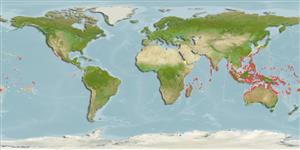Gastropoda |
Littorinimorpha |
Cassidae
Environment: milieu / climate zone / пределы глубины / distribution range
экология
; пределы глубины 0 - 12 m (ссылка 349). Tropical
Indo-Pacific: from East Africa, including Madagascar, Sri Lanka and the tropical islands of the Indian Ocean, through Indonesia and Melanesia, to eastern Polynesia; north to Taiwan Province of China and southern Japan, and south to northern Queensland and the Fiji Islands.
Length at first maturity / Size / Weight / Возраст
половая зрелость: Lm ? range ? - ? cm Max length : 18.0 cm SHL самец/пол неопределен; (ссылка 349); common length : 15.0 cm SHL самец/пол неопределен; (ссылка 349)
Shell well known as the main raw material from which cameos are cut. Species abundant only at the extreme western and eastern parts of its wide range, becoming rarer in its central part, corresponding with the Southeast Asian region (Ref. 349). Most common in fairly sheltered areas, on bottoms of coarse coral sand. Shallow subtidal waters. Preys on short-spined sea urchins (Ref. 349).
Life cycle and mating behavior
половая зрелость | размножение | нерест | Eggs | Fecundity | Larvae
Members of the order Neotaenioglossa are mostly gonochoric and broadcast spawners. Life cycle: Embryos develop into planktonic trocophore larvae and later into juvenile veligers before becoming fully grown adults.
Основная ссылка
ссылки | координатор | соавторы
Poutiers, J.M. 1998 Gastropods. p. 363-648. In Carpenter, K. E. and V. H. Niem. 1998. FAO species identification guide for fishery purposes. The living marine resources of the Western Central Pacific. Volume 1. Seaweeds, corals, bivalves, and gastropods. Rome, FAO. (ссылка 349)
Статус Красного Списка МСОП
(ссылка 130435: Version 2025-1)
Статус СИТЕС (ссылка 108899)
Not Evaluated
CMS (ссылка 116361)
Not Evaluated
Угроза для людей
Harmless
Использование человеком
| FishSource |
инструменты
дополнительная информация
Trophic EcologyFood items (preys)
состав пищи
потребление пищи
хищники
Population dynamicsростMax. ages / sizesLength-weight rel.Length-length rel.Размерный составMass conversionчисленность Life cycleразмножениеполовая зрелостьFecundityнерестEggsРазвитие икрыLarvae PhysiologyOxygen consumption
ресурсы в Интернет
Estimates based on models
Preferred temperature
(Ref.
115969): 24.7 - 29.3, mean 28.4 (based on 2621 cells).
Fishing Vulnerability
Low vulnerability (10 of 100).
Категория цены
Unknown.
